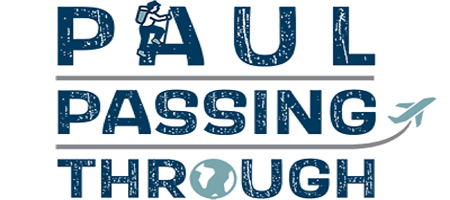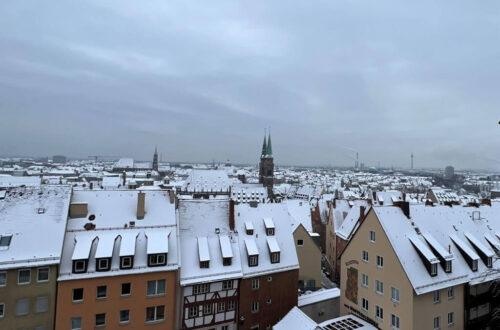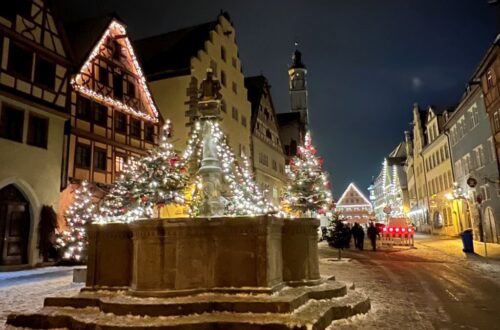A First-Timer’s Guide to Visiting Pompeii
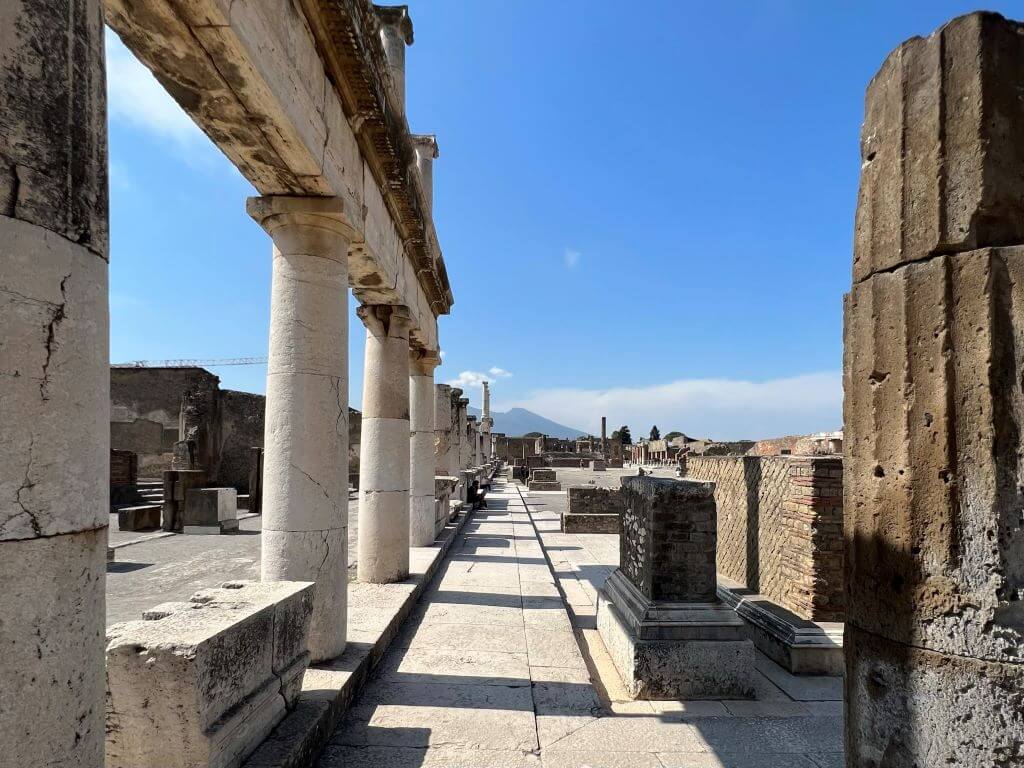
Visiting Pompeii for the first time can be exciting but stressful. You want to make sure you see everything, but until you actually set foot in the park, you don’t realize how extensive the ruins are. Add to that the heat and sometimes confusing layout and the experience can quickly become overwhelming.
This article goes over some of Pompeii’s highlights and my top tips to help your visit go smoothly and comfortably. After you’re done reading, you’ll be ready to visit Pompeii like a pro!
Disclaimer: This post may contain affiliate links. If you make a purchase through one of these links, I will earn a small commission. This occurs at no added cost to you.
Orientation to the Pompeii Ruins
| Hours | November – March Daily 9:00 – 5:00 (last entry at 3:30) April – October Daily 9:00 – 7:00 (last entry at 5:30) |
| Length of Visit | At least 2 – 3 hours but you could easily spend several hours here |
| Cost | €18 |
| Highlights | The Forum, House of Menander, House of the Faun the brothel, House of the Vettii, Baths of the Forum |
Take a look at my complete guide to visiting the Campania region for additional information on Pompeii, Herculaneum, Naples and hiking up Mount Vesuvius!
History of Pompeii
The Pompeii ruins are an extensive labyrinthine collection of ancient Roman ruins with Mount Vesuvius looming in the distance. At one time, Pompeii was a thriving city of 20,000 mostly middle-class citizens who relied on the city’s ideal location for trade between Rome and the rest of the Mediterranean.
It was a bustling city with chariots coming and going, an amphitheater that played host to gladiator fights, and regular Roman citizens who went about their business enjoying life in the thriving empire.
Then, all that came to a sudden, violent end in 79 A.D. when nearby Mount Vesuvius erupted and covered the city in layers of ash up to 6 meters deep. Many escaped, but an unfortunate few remained behind and would become entombed in ash and debris.
Unfortunate for them but fortunate for us 2,000 years later. As a result of this ashfall, Pompeii was almost instantaneously preserved to give us a picture into what life was like in the day of a Roman citizen during the empire’s heyday. It remained buried and largely forgotten until the 17th century when the king of Naples began excavations in the area after the nearby city of Herculaneum was discovered while diggers were looking for a spot to build a royal palace.
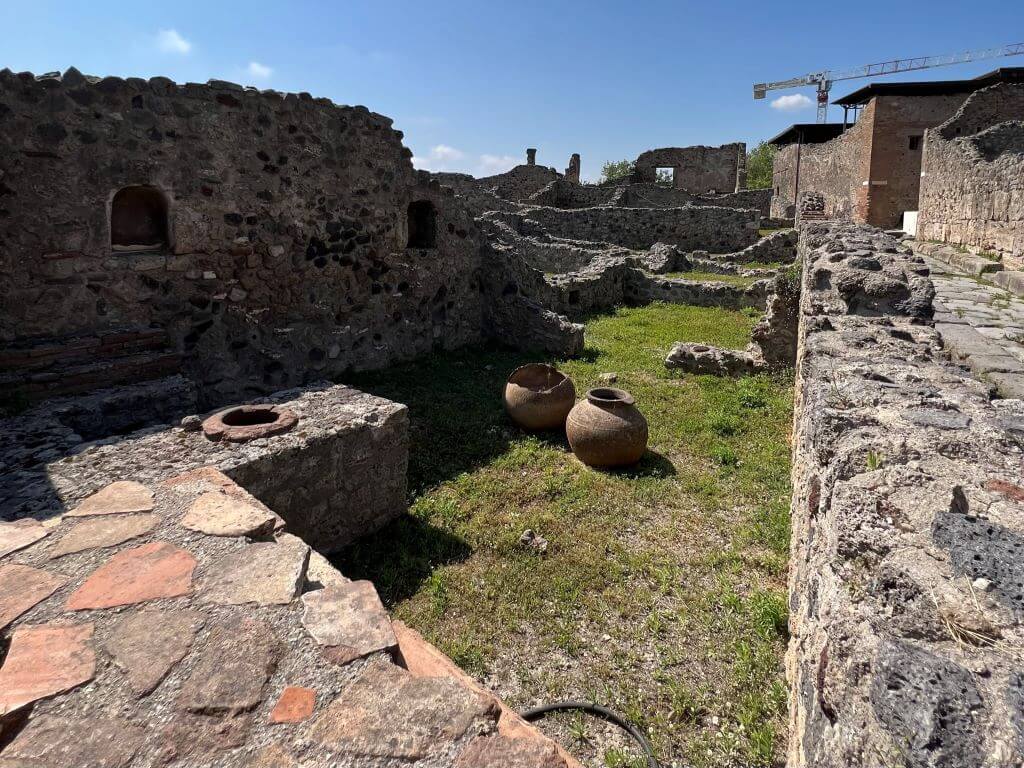
Fun Fact: You’ll quickly notice that most of Pompeii’s buildings are roofless. This is due to the initial eruption’s largest debris hitting Pompeii and destroying them. This is different from Herculaneum where the roofs are still largely intact. Herculaneum missed the initial eruption but would be encased by several pyroclastic flows later in the day.
Arrival in Pompeii
Pompeii has three entrances with Porta Marina being the one most tourists will use. From here, you can store any bags you have, use the restroom and, most importantly, pick up a map.
Once you enter, you’re more or less free to explore the ruins at your own leisure. Some sites might be roped off, but generally, you can walk anywhere you like.
There are a number of highlights to see (more info on these below). However, keep in mind that this is an active archaeological site where excavations and preservation efforts may be occurring during your visit. As a result, some buildings may be closed. Check here for the current hours of each individual site. This site also has information on any current closures.

Photo Tip: You should consider taking notes as you go of what you’re photographing. I didn’t, and now I have no idea what some of my photos are of.
Top Sights to See when Visiting Pompeii
One thing is for sure, you won’t leave Pompeii wishing you had seen more. Here are just some of the highlights to make sure you visit. Most of these are my personal favorites, but I did include a couple that we missed either due to closures or poor planning.
The Forum
The Forum is likely to be the first main sight in Pompeii you’ll see. It also happens to be the most recognizable sight in the park due to its popularity and photogenic nature.
This large square marks the cultural center of Pompeii with either end of the Forum marked by the Temple of Jupiter (the main god of the Roman religion) and City Hall. In addition to these two ruins, the granary and basilica are two other important buildings you can see here.
Besides the individual ruins, the Forum taken as a whole is great. Even in its ruined state, you can easily get a sense of the grandeur of the city as it once was. It also offers one of the best views of Mount Vesuvius.
Imagine the volcano just prior to its eruption. From the two peaks you can see today, you can trace lines further up to form a classic cone-shaped volcano. The people of Pompeii had no idea their mountain was an active volcano until the eruption that would immortalize their city began.
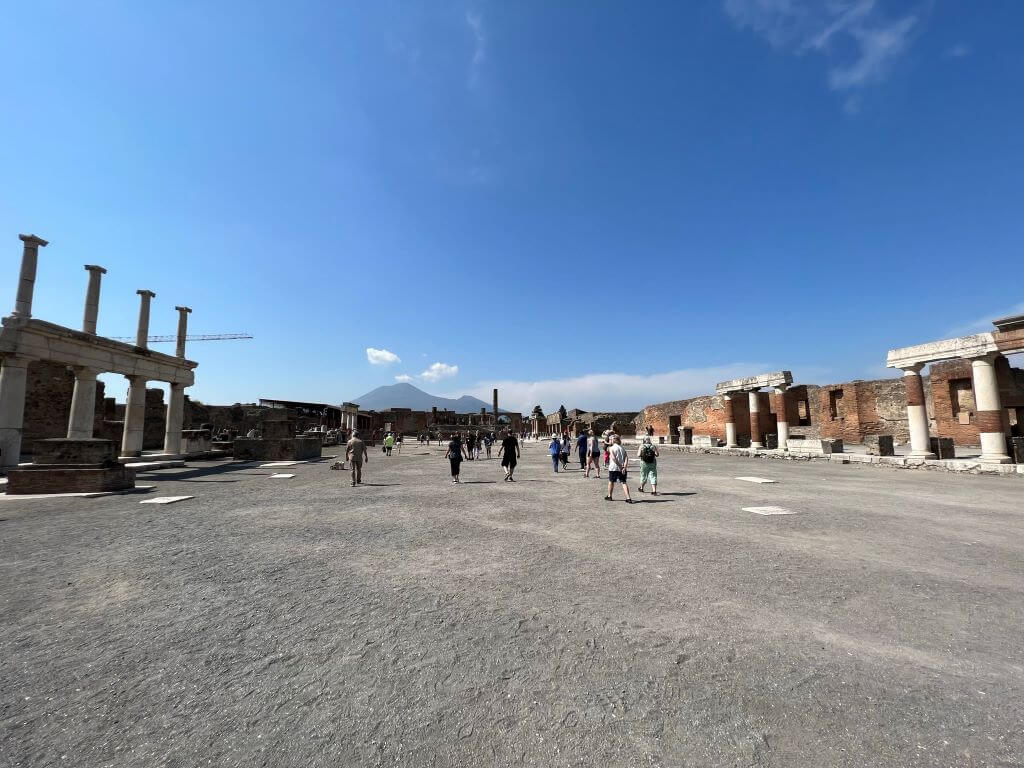


Baths of the Forum
Just adjacent to the Forum are these well-preserved baths. Walking through the baths, you’re able to see in detail the typical layout of Roman baths.
Within the Baths of the Forum are three different baths: one each for cold, warm and hot water. From these areas, you can see some of the Roman engineering used to heat the baths and produce steam, too. You can even see the dressing room with holes placed in the walls where pegs would have been to hang clothes.
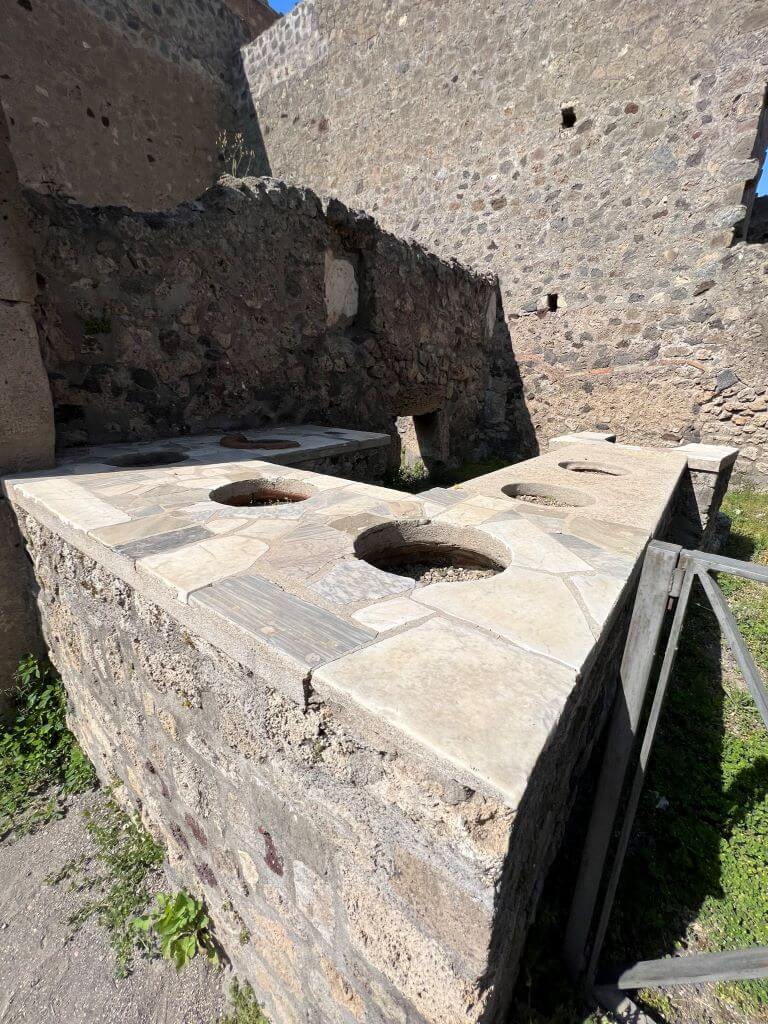
House of the Faun
The House of the Faun is the largest home in the park, and you’re free to explore all of it while visiting Pompeii. This home belonged to one of Pompeii’s wealthier citizens. As such, it contains many decorative motifs and mosaics to reflect its owner’s status.
The House of the Faun’s two most notable features are the faun statue in the courtyard and the Battle of Alexander mosaic in one of the side rooms. Despite both being reconstructions (the originals are located in the Naples archaeological museum), seeing these intricate pieces gives you a sense of the value placed on art in the Roman world.



House of the Vettii
The House of the Vettii was only recently reopened in its entirety to visitors in January 2023 after 20 years of restoration work. Prior to this, only small parts of the house were open, but it still resonated with me.
It’s renowned for the detail and quantity of its frescoes showing what life was like in Pompeii. The House of Vettii also has a number of frescoes and statues of a sexually explicit nature. Some of these were meant to symbolize the successful lives of the home’s owners. Others indicate that part of the home was used as a one-room brothel.
Because of the presence of some erotic artwork, we mistakenly thought this was the brothel. Again, pay closer attention to your map than we did while you walk around so you don’t miss any highlights like we did.
House of Menander
The House of Menander is another large home with a large number of finely preserved frescoes adorning its walls. Most of the frescoes show scenes from the Iliad and the Odyssey.
In the back courtyard of the House of Menander is a small display of skeletal remains found in Pompeii. These can warrant at least a quick visit for those interested in the more macabre side of tourism.

House of the Tragic Poet
Like many of the highlights on this list, the House of the Tragic Poet contains a number of well-preserved frescoes. Still, that’s not why it makes my list of highlights.
The House of the Tragic Poet has perhaps the first beware of dog sign in recorded history!
Besides being a fun detail, this sign acts as a bridge between the ancient and modern worlds. More than any other part of the park, this mosaic helped to ground me in the reality that these were real people with similar concerns and problems as us.

Garden of the Fugitives
A garden in only the most morbid sense of the word, the Garden of the Fugitives shows the last moments of a group of 13 Pompeiians.
On the second day of the eruption, these 13 people were believed to be trying to escape when a pyroclastic flow immediately and abrupty ended their lives. The debris entombed their bodies in ash which eventually rotted away leaving behind hollow cavities.
In 1961, they were discovered, and the cavities were filled with plaster to create molds that revealed each victim exactly as they were at the time of their deaths.
Don’t worry too much if you miss the Garden of the Fugitives for any reason. Several other spots in the park contain plaster casts, including the granary near the Forum.
The Brothel
One of the most popular buildings in Pompeii is the brothel. Sex sells, and that statement is apparently just as true today as it was 2,000 years ago.
The ground floor of the brothel consists of five rooms filled with a simple stone bed that was used by prostitutes to provide their *clears throat* services. Lining the walls of the brothel are frescoes depicting various sex acts. It’s unclear if these were meant to serve as advertising or simply decorations. Graffiti can also be seen from satisfied customers.
We managed to miss this popular spot while visiting Pompeii. If you make that mistake like we did, don’t fret. You can get your ancient erotica fix in other spots throughout Pompeii or the Secret Cabinet in the Naples National Archaeological Museum.
Be warned: You may want to research the areas with erotic art ahead of time if you have kids. Some of the frescoes don’t leave much for the imagination.
Other Things to do After Visiting Pompeii
Campania still has more in store for you after you’re done with Pompeii if you have more time. You have a range of activities to choose from depending on your interests.
Naples National Archaeological Museum
For an up-close look at Pompeii’s history, head to the Naples National Archaeological Museum. In addition to holding other antiquities from the ancient world, this museum is renowned for housing many of the statues, mosaics, frescoes and other objects from Pompeii and nearby Herculaneum. Whereas visiting Pompeii shows you the scale of the actual city, this museum gives you a more detailed look into their culture.
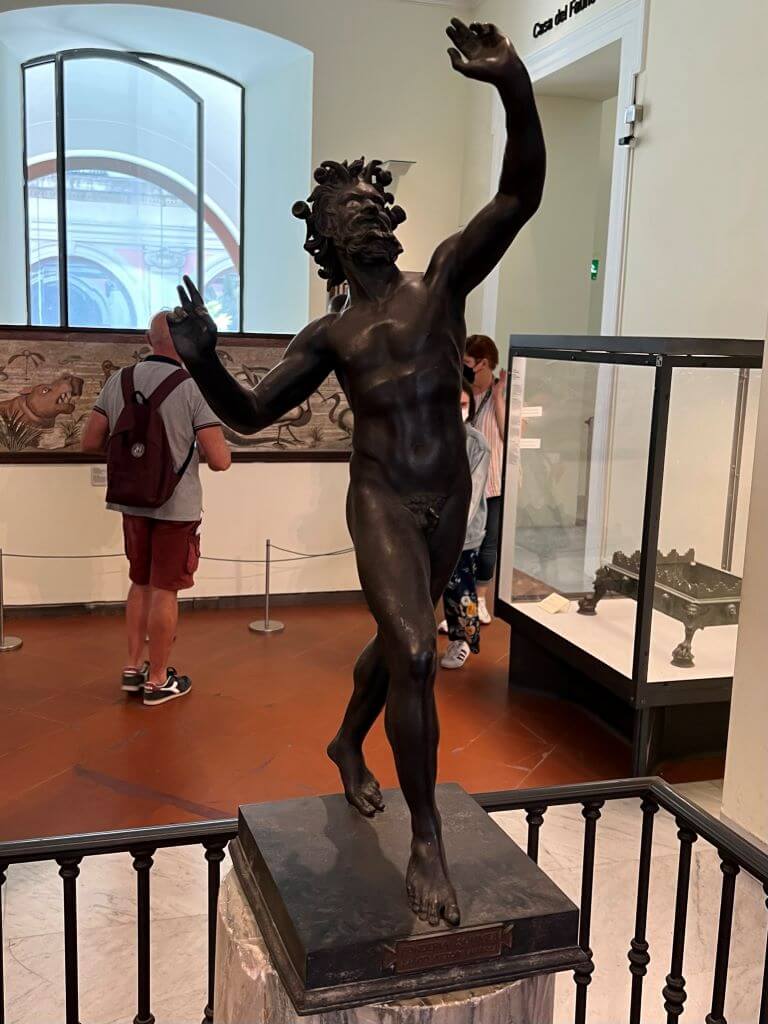
We visited the Naples National Archaeological in the morning before going to Pompeii. I liked this strategy because it helped me to better conceptualize the ruins as we explored them. That said, we did experience some museum fatigue in Pompeii that wasn’t helped by the heat. Still, I think visiting the museum first is the better option as long as you pace yourself appropriately.
Ruins of Herculaneum
Herculaneum is the smaller, sometimes-forgotten sister city of Pompeii that succumbed to Vesuvius’ eruption in 79 A.D. Unlike Pompeii, the ruins here are better preserved because of how the volcano erupted. Pompeii received the initial brunt of falling rock and debris, which destroyed its roofs. Herculaneum, however, was spared this first impact but was later buried almost instantaneously by several pyroclastic flows.
Because of this timeline, visitors can actually get a better idea of what this city looked like compared to Pompeii. Further, since it lacks Pompeii’s grandeur, Herculaneum tends to be less crowded, giving visitors a more intimate experience.
Mount Vesuvius
After seeing the devastation wrought by Mount Vesuvius, why not give it a climb for a sense of the scale of this volcano?
Various companies offer rides up the mountain allowing you to easily bypass all but the last 30 minutes or so to the crater’s rim. From here, you can walk around the rim on the mountain’s loose, ashy soil while imagining the hellscape it must have been during its eruption in 79 A.D. If you’re lucky – or not – you may even see steam billowing out from the crater’s depths.
Equally stunning are the views away from the crater towards the Bay of Naples where you can see the coastline stretching from Naples all the way to Sorrento.
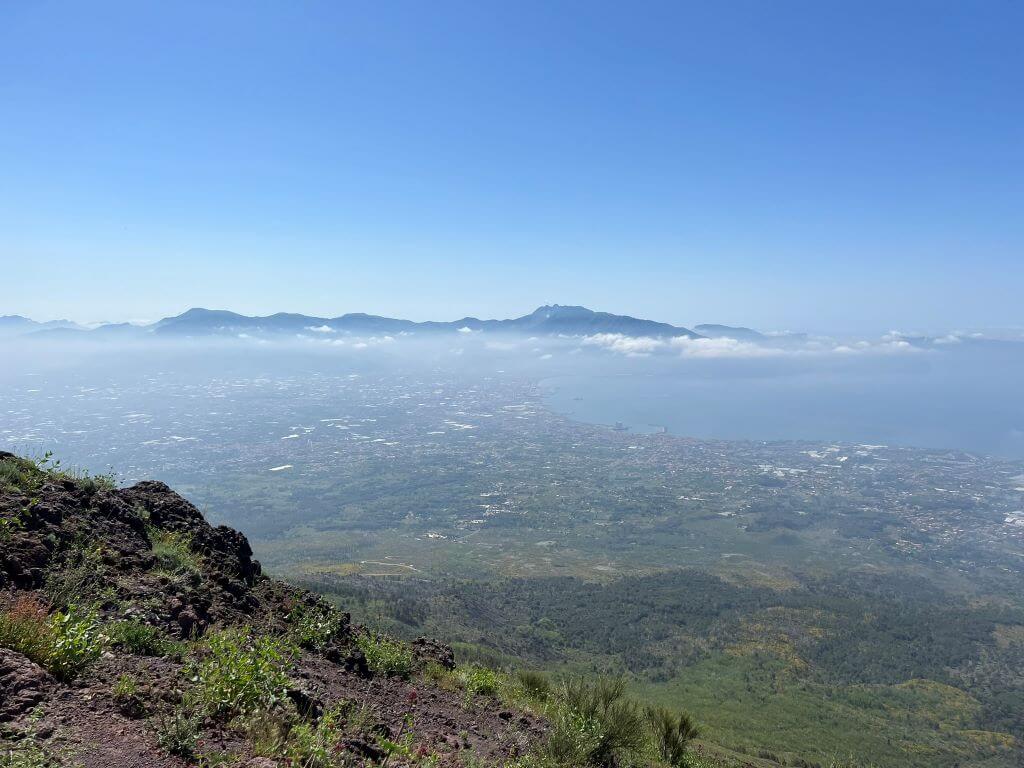
Don’t forget to book a ticket to enter the national park ahead of time! The park service does sell tickets at the gate, but they tend to sell out. I saw at least one couple take a bus all the way up only to be turned away because they didn’t have tickets.
Sorrento
Sorrento is waiting for you a bit farther down the coast for when you’re ready for a break. It’s a sun-soaked resort town with a beautiful harbor and inviting downtown with a variety of cafes, restaurants and shopping. If that’s not enough, the gorgeous Isle of Capri is just a quick ferry away.
This is your chance to just relax with a vino, take in the views and reflect after visiting Pompeii.

A Guided or Self-Guided Tour for Visiting Pompeii?
While we didn’t use a guided tour, I would strongly encourage anyone visiting to hire one when visiting Pompeii for the first time. Typically, I’m rather anti-guided tour, but Pompeii is so extensive and devoid of signage, that our visit suffered some as a result.
I studied beforehand, we picked up a map from the entrance, and I had a walk with historical information and a recommended route through the ruins downloaded on my phone ready to go. Everything went well with our self-guided tour for all of around 20 minutes when we very quickly became lost.
If you try a self-guided visit, make sure to pay close attention to every detail about your route as you go. Once you get out of the forum, many of the ruins start to look the same from the street. What’s more, if you’re like me and you like to wander, it can be fun to explore Pompeii in this manner, but it’s easy to get turned around amid the ruined walls.
To make matters worse, signage isn’t great, and the map isn’t the easiest to follow making it difficult to reorient yourself. It’s easy to get lost amid the ruins. Make sure to check in frequently with the map to confirm where you are in the park.
With patience, we could eventually piece together where we were. However, between the heat of southern Italy and the exhaustion from walking through the ruins, this process quickly became frustrating. It was also just plain time consuming, too.
It was still fascinating, but I feel like we didn’t get quite the full experience. For instance, we completely missed the brothel, one of the most popular buildings in the whole site.
Pompeii also offers visitors an audio guide for €8 that has an interactive map included. This could be a good, cheaper option compared to hiring a tour guide if you like audio guides.
So, while it is possible to do a self-guided tour, save yourself the hassle and spend some extra money to give yourself a better experience!
Things to Bring when Visiting Pompeii
Comfortable, sturdy shoes are an absolute must for Pompeii. The ruins are larger than they look on a map, so you will be doing a lot of walking. On top of that, the roads are uneven and dusty, which can make walking in sandals or flip-flops challenging.
Sunscreen will help to keep your skin safe while walking through exposed ruins. Except for the rare shadow, Pompeii is almost totally exposed to the sun thanks to all that ash from Vesuvius collapsing the buildings’ roofs.
Sunglasses and/or a hat are important for the same reason that sunscreen is. Unless you enjoy squinting for several hours straight, don’t forget these items.
A reusable water bottle is handy for keeping you hydrated in the heat of Pompeii. Just like the rest of Italy, these ancient ruins have several perfectly safe public fountains to fill up your bottle as you explore the site. Food is also available within the park if you need a quick bite to eat while visiting.
Lightweight and light-colored clothes are helpful in the heat to keep you comfortable and cool. If you still need reminded after reading this list, it can get hot in Pompeii. Opt for comfort over style.
Tickets! You can buy tickets at the entrance, but purchasing them ahead of time will let you skip what can be a long line. Don’t let my photos fool you. We were lucky with small crowds. Pompeii is typically much more crowded.

How to Get to the Pompeii Ruins
Pompeii is a popular day trip from Rome or Naples because of its location right next to the Pompei Scavi-Villa dei Misteri train station.
Bags are not allowed in the ruins, but there is a storage locker near the entrance that you can use for a small fee.
From Naples
If coming from Naples, take the regional Circumvesuviana train from Garibaldi Station (on the bottom floor of Napoli Centrale) to Pompei Scavi-Villa dei Misteri. The train takes about 35 minutes and runs twice per hour. Make sure you take a train going to Sorrento, otherwise you’ll end up somewhere other than the Pompeii ruins. Circumvesuviana trains aren’t always clearly marked, so ask a local to be sure you’re on the right line.
There is also the Campania Express that goes to Pompeii Scavi from Garibaldi Station. This train follows the same line as the Circumvesuviana but is slightly quicker. The downside is that these are far less frequent, running only four times per day.
From Rome
To do Pompeii as a day trip from Rome, take a Trenitalia train from Roma Termini to Napoli Centrale. From there, follow the steps outlined above. These trains run about two to three times per hour and take a little over an hour to arrive in Naples.
If you’re looking for other day trip ideas from Rome, why not give Orvieto a try. You’re bound to fall in love with its charming, medieval streets and stunning duomo!
In Pompei
For those staying in the adjacent town of Pompei, there are two other entrances besides Porta Marina by Pompeii Scavi station: Piazza Esedra and Piazza Anfiteatro. There are some key differences to note between each entrance.
Porta Marina is the main entrance located across from the train station, but that means it is about a 15-minute walk from town. Most visitors will use this entrance, which could also mean longer lines if you haven’t booked ahead. On the other hand, it does have the most facilities and is open the longest compared to the other two. You can use this entrance from 8:30 to 7:00.
Piazza Esedra is located a short walk from Porta Marina. This entrance is less crowded because it is generally used by groups, but individuals can use it to avoid crowds. The main downside is its lack of facilities compared to Porta Marina. This entrance is open from 8:30 to 5:30.
Piazza Anfiteatro is ideal for people who are staying in the middle of Pompei. It has facilities, including a bathroom, ATM and a bookshop. This entrance is open from 8:30 to 5:30.

Don’t miss my tips and thoughts for planning your trip to Italy. This resource is another valuable tool for first-time visitors!
Thank you for reading this post. Paul Passing Through is a labor of love to which I’ve dedicated a lot of free time. If you’d like to show your support for my blog, you can Buy Me a Coffee to help fund the future of Paul Passing Through. I appreciate any contributions!
Resources to Book Your Trip to Pompeii
Whether you’re looking for tours, hotels or flights, here are some tools to help get you started planning your trip to Pompeii!
Look for activities and tours offered through GetYourGuide or Viator!
Search Flights
Still can’t find what you’re looking for? Check out my travel essentials pages for more of my recommendations.
Pin This Post!


